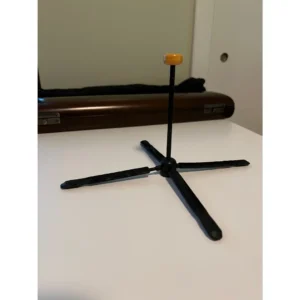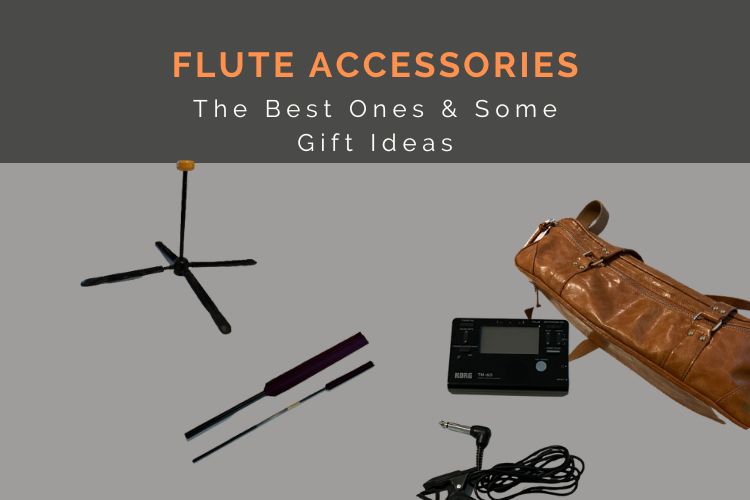If you just started playing the flute, you may wonder what flute accessories you need to get to help make the most of your new instrument.
Read on as I unveil some essential accessories for flute players of all levels, as well as give some ideas for flute accessories gifts.
- What are the best accessories for a flute?
- What are some flute cleaning supplies or accessories?
- Get some ideas for flute accessories gifts
Best Flute Accessories
When learning the flute, having a few flute accessories can help. Here are some items I’d recommend for most players.
Flute Stand
A flute stand is a small item that has a good base and a peg to hold your flute upright.
That way, you can set it down during a practice break. It’s also useful if you need to switch from the flute to another instrument in a performance.
I’d recommend the stands from Hercules.
The Travelite stand is small and compact, so it fits in your case. However, there’s also this Hercules stand that fits two flutes or clarinets along with a piccolo, and this stand is much sturdier.
Either way, having a stand means you don’t have to lay your flute on the ground or a chair and risk yourself or someone else sitting or stepping on it.
Best Value
The Hercules Travelite stand (DS460B)
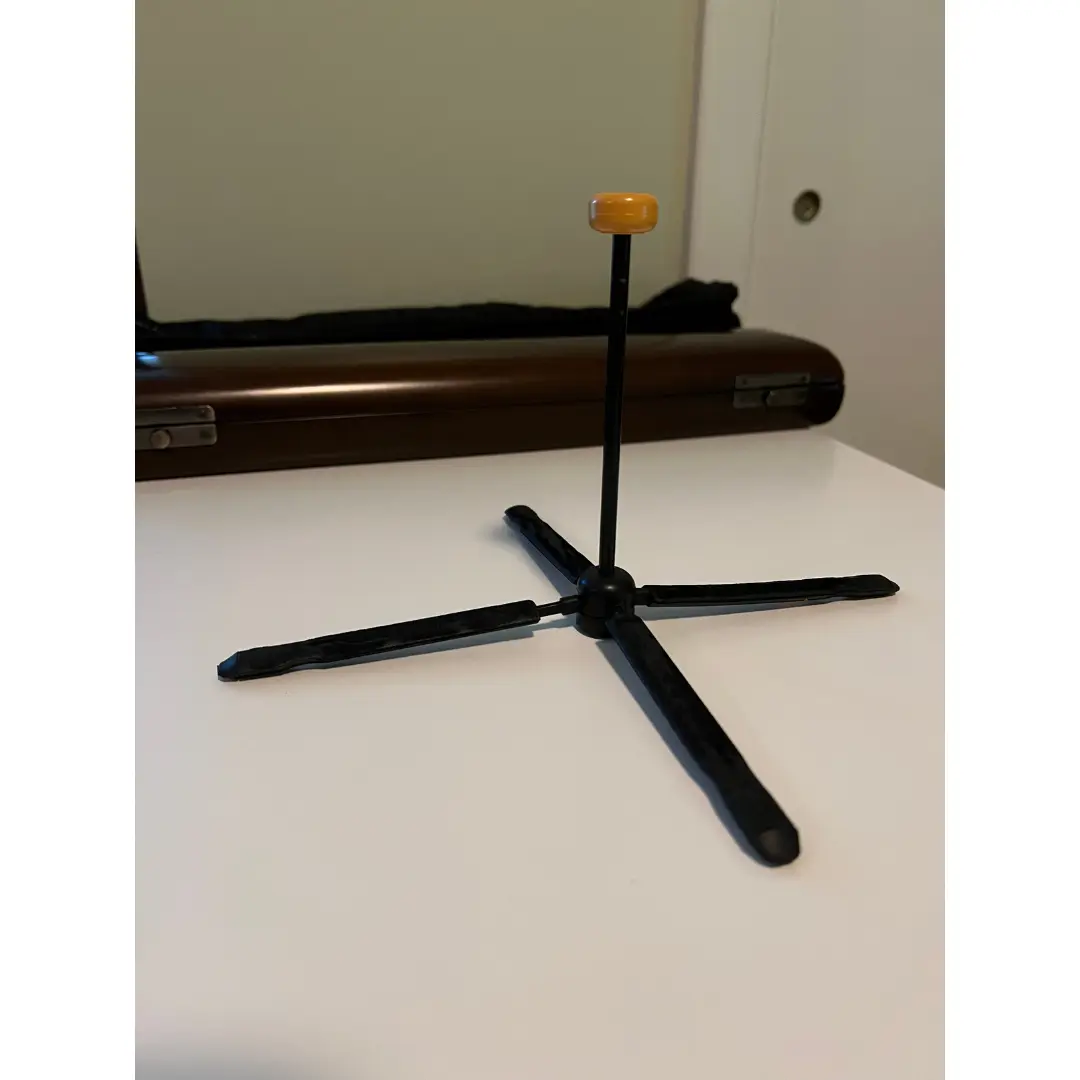
Premium Pick
The Hercules DS543BB
Metronome-Tuner
Every musician can use a good metronome and tuner, and some come as one device.
I have and love the Korg TM60BK.
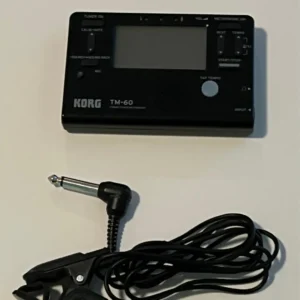
The reason I’d recommend it over other tuners is that it comes with a cable that connects to your instrument.
You can clip it to the barrel or headjoint, and it will only pick up the vibrations from your flute.
If you need to tune before an ensemble rehearsal, it won’t pick up other players. That way, you can get a more accurate gauge of if you’re in tune.
The Korg TM60BK Metronome Tuner
If you don’t want to carry a physical tuner, there are many apps, like Tunable. They’re usually free or cheap, but they don’t have the cord that connects to the flute.
FIXIT Multi-Tool
Another accessory that many flutists should have is a FIXIT Multi-Tool.
I’ve had one for multiple years, and it’s come in handy a few times.
One side features a flathead screw, which is what you need if you need to tighten or loosen the screws on your flute.
The other side has a hook, which you can use to pull a spring back into place. You should take your flute to a professional for regular maintenance. However, such a tool for a flutist is a great way to keep your instrument in good shape between professional cleanings.
If you’re a total beginner, I’d recommend having your teacher or a flute expert use the tool. But as you learn to play the flute, you can learn how to adjust the screws yourself.
Pad Paper
As you play the flute, condensation can build up. Now, you shouldn’t worry too much if you swab out your flute whenever you play.
However, the condensation can still cause issues, such as sticky or wet pads.
If that happens, you can use some pad paper to blot the pads of the affected keys.
A Yamaha Cleaning Paper
You can also use cigarette paper, but I’d recommend pad paper since it’s a specialty product. It also won’t have a sticky line like cigarette paper, and you don’t need to go to a smoke shop to buy it.
When you use the pad paper, place it under a key and close the key a few times. Don’t pull the paper from a closed key because you could rip the pads.
Flute Wand
You may already have flute clean accessories like a cleaning rod and swab, but I’d also recommend getting a Valentino Flute Wand. The wand is plastic and has fabric covering one end. That makes it easy to swab out your flute quickly.
I bought mine from my flute technician, and she sold it to me with an extender.
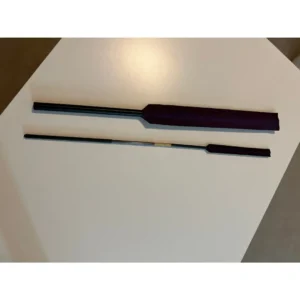
The extender makes the wand long enough to use without disassembling my flute. So if I need to swab out my flute quickly, I can do so.
If you play the piccolo, I’d also recommend the Valentino Piccolo Wand. It works the same way but is small enough for the piccolo.
Earplugs
Another one of the best flute accessories is a set of earplugs.
As you start playing high notes, the notes can sound a lot louder. Of course, if you also play the piccolo, the high notes will sound even louder since the instrument is much closer to your right ear.
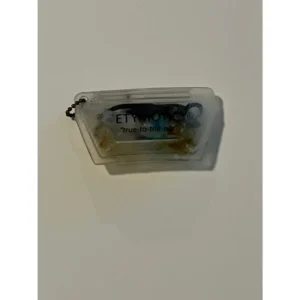
I’d recommend using earplugs whenever you play the piccolo.
If your ears are sensitive, you can also use an earplug in your right ear when playing the flute.
I like the Etymotic earplugs because they don’t totally block the sound, so you can still hear yourself.
The Etymotic earplugs
Thumb and Finger Guides
Some players love to use thumb and finger guides, like a Thumbport or Bo Pep finger saddle.
The Etymotic earplugs
You can use these to remind yourself of where to place your finger and thumb. That makes them a great accessory for beginners.
However, you can continue to use them as extensions if you have small hands.
For example, the Thumbport makes the tubing of the flute seem a little thicker, and that can help you place your thumb in a comfortable spot to hold the flute.
LeFreque
The LeFreque is probably one of the most controversial flute accessory out there.
These metal sound bridges go where the headjoint meets the body to help connect them.
I’ve tried a few on my piccolo, and they changed the sound slightly but not enough to buy one. Other players swear by their LeFreque sound bridge and use it all of the time.
However, they can be quite expensive, especially the solid silver models. They also extend the time it takes to assemble and disassemble your flute.
Win-D-Fender
Another somewhat controversial gadget is the Win-D-Fender.
The device goes over the area of the embouchure hole on your headjoint and blocks wind. That way, you can get a clearer sound even when you’re performing outside.
I haven’t tried one, but I’ve never struggled to play in windy conditions. But if that’s a problem for you, it can be worth trying the Win-D-Fender.
Some people have started using it after the COVID-19 pandemic to block air particles. However, from my understanding, it only keeps air out of your embouchure not in. If that’s the case, it won’t do much to stop the spread of germs.
Pneumo Pro
The Pneumo Pro is a teaching tool rather than a regular flute accessory.
It looks like a regular flute headjoint and has a series of fans attached. Those fans give you a visual of where your airstream is going as you blow into the flute.
Pneumo Pro
Some teachers swear by this gadget and use it with all of their flute beginner students.
You can use it yourself if you aren’t a teacher. That way, you can see if your air is even entering the headjoint or if you need to blow farther up or down.
Flute Accessories Gift Ideas
You can also ask for accessories as gifts for flute players. Whether an accessory is too expensive or you otherwise don’t want to buy it yourself, put it on your wishlist.
Here are some flute accessories to give or receive as a flute gift.
Flute Bag
Beginner flutes usually come in a hardshell case, but that case hardly has any space for any flute accessory. Some advanced flutes have a case cover, but the cover may not have enough space for everything.
In either case, a flute bag or case cover makes the perfect gift.
If you know a flutist who likes fashion, consider getting them a stylish Fluterscooter bag, which holds a flute, piccolo, and plenty of other gadgets.
Fluterscooter bag
There’s also the Altieri Combo Traveler, which fits your instruments, sheet music, and other gear.
I have one that’s big enough for my alto flute, and I love how much I can store inside.
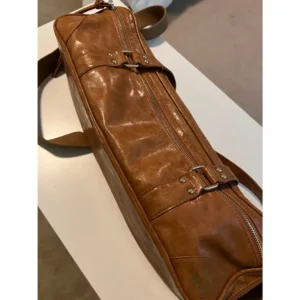
The Altieri Combo Traveler
Picc Pocket
The perfect flute accessory gift for piccolo players is the Picc Pocket.
It sits like a crossbody bag strap but without the bag. The bag has slots for your piccolo, a cleaning rod, and a pencil, and it can keep your piccolo warm when you aren’t playing.
I’ve experimented with one, and I love the concept.

You don’t have to carry your piccolo and accessories, which is great if you also have to carry a flute to and from a concert stage. But you have to figure out how to adjust it so that it sits comfortably on your chest.
Flute Hats
Not all flute accessories have to be expensive. If you’re crafty, you can make a flute hat for the flutist in your life. This is a small hat that they can put on the closed end of their headjoint to make it look like their flute is wearing an accessory.
You can use yarn to craft, or you can buy one that’s already made. These gifts are great for flute teachers to give to their students. They also make for a fun group activity, so you and your students can make them together and give hats to each other.
FAQs
If you still have questions about flute accessories, you’re not alone. Here are a few more things you should know.
What accessories do you need for a flute?
The only accessories you need would be flute cleaning supplies, like a flute wand. But I’d also recommend a tuner, earplugs, and a flute stand to start. You can collect other accessories later.
What cloth should you use to clean your flute?
You can use a variety of materials, but I’d recommend silk, bamboo, or cotton cloths. They all can absorb moisture, so they’re perfect for swabs. Avoid polishing cloth. To clean the outside, use a microfiber or cotton cloth.
How long does a flute last?
Some flutes can last for years or decades with the right accessories and care. If your flute stops playing as well as it has, take it to a flute technician. They can clean it up and get it to play like new, and you can get more use out of your flute.
